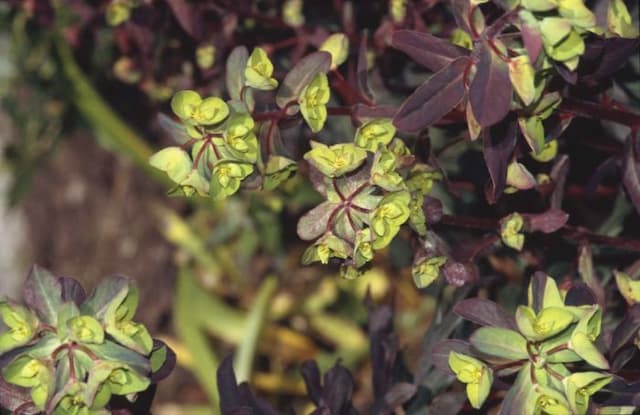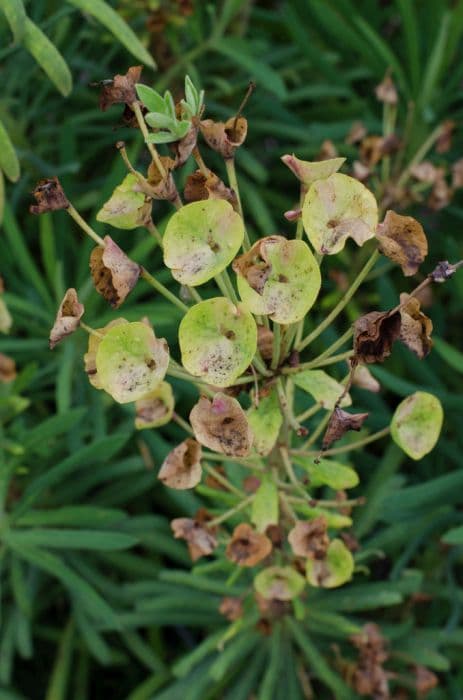Spurge Euphorbia 'Abbey Dore'

ABOUT
The Euphorbia 'Abbey Dore' is a striking plant with a bushy, clump-forming habit. Its foliage is primarily a rich green color with a dense arrangement of leaves. The leaves are oblong with a slightly serrated edge, imparting a lush and textured appearance to the overall foliage. During its blooming period, this Euphorbia showcases vibrant yellow-green flowers, sometimes referred to as bracts or cyathia, which add a bright pop of color against the green foliage. These floral structures are unique, with no distinct petals, rather consisting of a central, cup-like part that holds nectar. This plant's overall appearance is robust and vigorous, presenting a visual interest with its contrasting flower and leaf colors which make it a notable addition to any garden arrangement where it can be planted to complement other ornamental species.
About this plant
 Names
NamesFamily
Euphorbiaceae
Synonyms
Spurge
Common names
Euphorbia 'Abbey Dore'
 Characteristics
CharacteristicsLife cycle
Perennials
Foliage type
Semi-deciduous
Color of leaves
Green
Flower color
Yellow
Height
2 feet 24 inches (61 cm)
Spread
2 feet 24 inches (61 cm)
Plant type
Shrub
Hardiness zones
5
Native area
Mediterranean
Benefits
 General Benefits
General Benefits- Drought Tolerance: Euphorbia 'Abbey Dore' is highly drought-tolerant, making it suitable for xeriscaping and low-water gardens.
- Easy Maintenance: This plant requires minimal care once established, with no need for frequent watering or fertilizing.
- Long Blooming Season: It provides a long period of visual interest, with blooms lasting from late spring to summer.
- Attracts Pollinators: The flowers attract bees and butterflies, promoting biodiversity in the garden.
- Deer Resistance: Euphorbia 'Abbey Dore' is not favored by deer, making it an excellent choice for gardens in areas with deer populations.
- Architectural Form: Its unique structure and foliage add visual structure and interest to garden beds and borders.
- Seasonal Interest: With foliage that changes color over the seasons, it provides year-round garden interest.
- Soil Versatility: It's adaptable to a range of soil types, although it prefers well-drained soil.
 Medical Properties
Medical PropertiesThis plant is not used for medical purposes.
 Air-purifying Qualities
Air-purifying QualitiesThis plant is not specifically known for air purifying qualities.
 Other Uses
Other Uses- Euphorbia 'Abbey Dore', commonly known as spurge, can be used as a dye plant; the milky sap contains certain compounds that can impart a yellow color to fabrics and other materials.
- Due to its unique appearance, spurge can be used in floral arrangements, particularly modern or non-traditional designs, to add an architectural element.
- Spurge can be used in the creation of living fences or garden borders as they can form dense clumps that are difficult to penetrate.
- The sap of spurge has been historically used as a fish poison in some cultures; it can be introduced into small bodies of water to immobilize or kill fish for easier collection.
- Euphorbia 'Abbey Dore' can contribute to frost resistance in the garden; the waxy coating on the leaves and stems can protect it during light frosts, serving as a natural insulator for itself and nearby plants.
- Some spurge species are used as a model organism in botanical and agricultural research due to their resilience and fast-growing nature.
- In some regions, spurge is planted as a companion plant to deter certain pests from more sensitive crops due to its toxic sap.
- The sculptural form of spurge can be incorporated into landscape design as a focal point or accent plant; their striking forms complement many garden styles.
- Dried spurge is also used in crafts or as a part of potpourri mixtures because of its interesting seed pods and lasting structure.
- Photographers sometimes use spurge as a subject for botanical photography, taking advantage of the plant's unique structure and the way it interacts with light.
Interesting Facts
 Feng Shui
Feng ShuiThe Spurge is not used in Feng Shui practice.
 Zodiac Sign Compitability
Zodiac Sign CompitabilityThe Spurge is not used in astrology practice.
 Plant Symbolism
Plant Symbolism- Resilience: Euphorbia species are known for their ability to thrive in challenging conditions, symbolizing strength and the capacity to endure hardships.
- Protection: The milky sap of Euphorbia is toxic and can deter herbivores, making the plant a symbol of defense and self-protection.
- Healing: Historically, some Euphorbia species have been used in traditional medicines, signifying healing and the soothing of ailments.
 Water
WaterThe Spurge, specifically the variety Euphorbia 'Abbey Dore', requires moderate watering, ensuring the soil is allowed to dry out between watering sessions. Water this plant approximately once a week, providing about 1 gallon of water for larger outdoor plants, and 8-16 ounces for smaller indoor pots, depending on the size of the container and the environmental conditions. During the active growing season in spring and summer, you may need to water more frequently, while in the fall and winter, reduce watering as the plant goes into dormancy. Always check the top inch of the soil for dryness before watering to avoid overwatering, which can lead to root rot.
 Light
LightSpurge prefers bright, indirect sunlight and can tolerate partial shade. It thrives best in a location that receives morning sun and afternoon shade, or dappled light throughout the day. Avoid placing it in full, intense afternoon sun, as this can cause the leaves to scorch. An east or west-facing window is ideal for indoor specimens, while in the garden, a spot that gets filtered sunlight under a high canopy or a position with morning sun would be suitable.
 Temperature
TemperatureSpurge grows optimally at a temperature range between 60 and 75 degrees Fahrenheit, but it can tolerate temperatures as low as 50 degrees and as high as 85 degrees. It is not frost-tolerant, so if growing outdoors, provide protection from temperatures below 50 degrees. To ensure the health of Euphorbia 'Abbey Dore', avoid sudden temperature fluctuations and extreme heat or cold.
 Pruning
PruningPruning Spurge is typically done to remove spent flowers and shape the plant. Prune Euphorbia 'Abbey Dore' immediately after flowering, usually in late summer to encourage branching and maintain its desirable form. Use gloves when pruning, as the plant's sap can be irritating to skin and eyes. You may also cut back any damaged or diseased stems as needed to maintain the plant's health.
 Cleaning
CleaningAs needed
 Soil
SoilEuphorbia 'Abbey Dore', commonly known as Spurge, thrives in well-draining, sandy or loamy soil with a neutral to slightly alkaline pH of about 6.5 to 7.5. A good soil mix recipe includes equal parts of potting soil, coarse sand, and perlite or pumice to ensure proper aeration and drainage.
 Repotting
RepottingSpurge should be repotted every two to three years to refresh the soil and accommodate root growth. Choose a slightly larger pot each time to prevent overcrowding, ensuring it has adequate drainage holes.
 Humidity & Misting
Humidity & MistingSpurge prefers moderate to low humidity levels, typical of indoor household environments, without the need for any special humidity adjustments.
 Suitable locations
Suitable locationsIndoor
Place Spurge in bright, indirect light and avoid overwatering.
Outdoor
Plant Spurge in full sun to partial shade; water sparingly.
Hardiness zone
6-9 USDA
 Life cycle
Life cycleEuphorbia 'Abbey Dore', commonly known as Spurge, begins its life cycle when seeds germinate in spring, provided they are sown in well-drained soil and have enough warmth and light. The seedlings emerge and grow throughout the spring and summer, developing a deep taproot and a rosette of leaves. As a perennial, the plant matures in its second year, forming an upright, bushy clump of foliage and then flowering in late spring to early summer. The characteristic inflorescences, which consist of cyathia (specialized floral structures unique to Euphorbia), are surrounded by showy, colorful bracts that attract pollinators. After pollination, the plant produces seed capsules that burst open when ripe, dispersing seeds for new growth. In the autumn, Euphorbia 'Abbey Dore' may die back to the ground in colder climates, with its root system surviving underground to sprout anew come spring.
 Propogation
PropogationPropogation time
Spring-Summer
Euphorbia 'Abbey Dore', commonly known as a spurge, is most effectively propagated using cuttings. The ideal time for taking cuttings is in late spring or early summer when the plant is actively growing. To propagate, select a healthy stem and cut a 3 to 5-inch (approximately 7.5-12.5 cm) portion with a sharp, clean knife or secateurs. Allow the cut end of the stem to callous over for a day before planting to reduce the risk of infection. Dip the calloused end in rooting hormone powder to encourage root growth and plant it in a well-draining soil mix. Keep the soil moderately moist and the cutting in a warm, but not hot, location with filtered sunlight. Roots typically develop within a few weeks, after which the new Euphorbia 'Abbey Dore' can be gradually acclimatized to its typical growing conditions.









